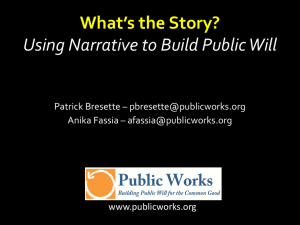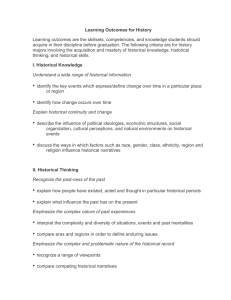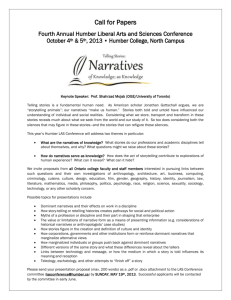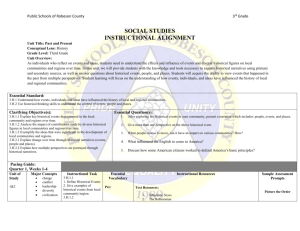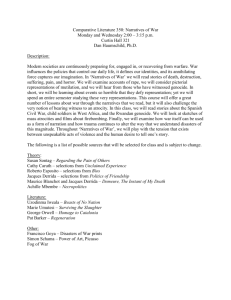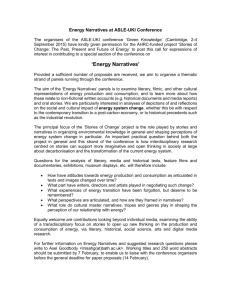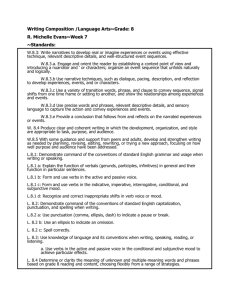Trending Stories Proposal
advertisement
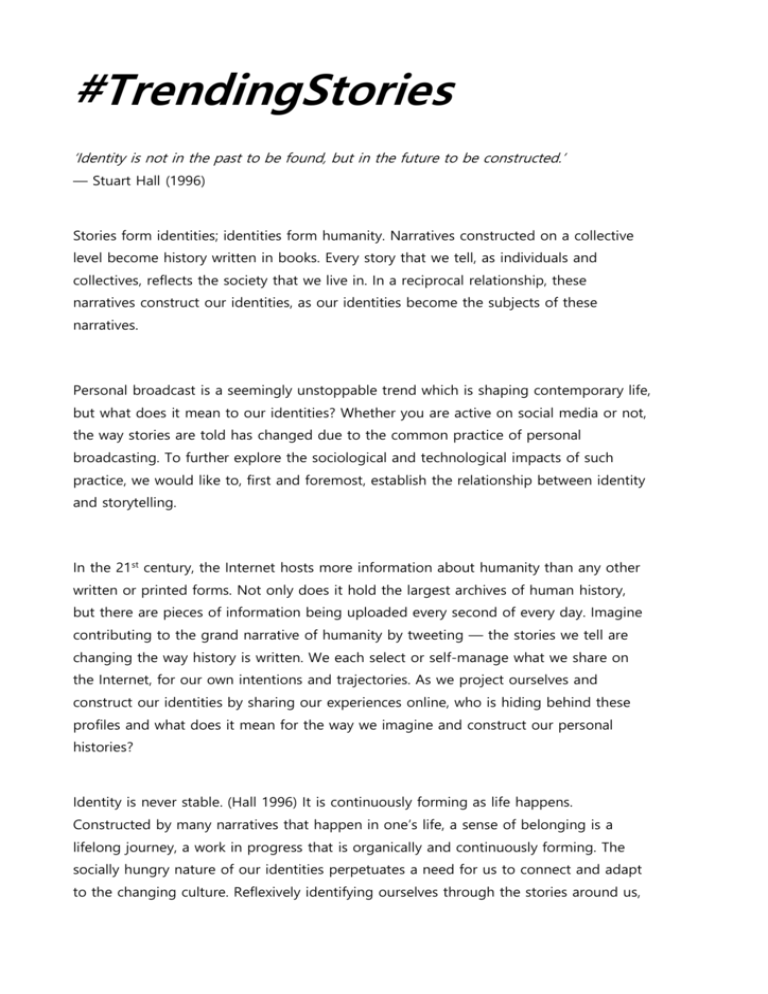
#TrendingStories ‘Identity is not in the past to be found, but in the future to be constructed.’ — Stuart Hall (1996) Stories form identities; identities form humanity. Narratives constructed on a collective level become history written in books. Every story that we tell, as individuals and collectives, reflects the society that we live in. In a reciprocal relationship, these narratives construct our identities, as our identities become the subjects of these narratives. Personal broadcast is a seemingly unstoppable trend which is shaping contemporary life, but what does it mean to our identities? Whether you are active on social media or not, the way stories are told has changed due to the common practice of personal broadcasting. To further explore the sociological and technological impacts of such practice, we would like to, first and foremost, establish the relationship between identity and storytelling. In the 21st century, the Internet hosts more information about humanity than any other written or printed forms. Not only does it hold the largest archives of human history, but there are pieces of information being uploaded every second of every day. Imagine contributing to the grand narrative of humanity by tweeting — the stories we tell are changing the way history is written. We each select or self-manage what we share on the Internet, for our own intentions and trajectories. As we project ourselves and construct our identities by sharing our experiences online, who is hiding behind these profiles and what does it mean for the way we imagine and construct our personal histories? Identity is never stable. (Hall 1996) It is continuously forming as life happens. Constructed by many narratives that happen in one’s life, a sense of belonging is a lifelong journey, a work in progress that is organically and continuously forming. The socially hungry nature of our identities perpetuates a need for us to connect and adapt to the changing culture. Reflexively identifying ourselves through the stories around us, the concept of ‘who we are’ is in constant flux. Identity, although mostly understood externally and retrospectively, has a certain attachment to history, place and others — stories from the past and narratives in the present. The strong relationship between our understandings of ourselves and the narratives of others, suggests that the methods of storytelling: its channels, its language, its environment; are crucial to the way we live and learn about each other. In the digital age, connectivity has allowed different narratives to meet frequently, elaborately and collaboratively. Instant photo-sharing culture is an example of this — the way in which an event can be captured, documented and shared from many perspectives and across many platforms. From fragmented information sources such as Twitter, YouTube and Facebook, to the published material from around the world across multiple platforms, the stories of our time are illustrated in fragments and in multimedia, transnationally. As we are getting, to some extent, closer to each other, what does it mean to our sense of belonging in the globalised world? What is the relationship between these new ways of storytelling and our citizenships? Personal Broadcast & The Social Network Every second on the Internet, there are tens of thousands of tweets and Instagram photographs uploaded by individuals. From tweeting, blogging, to ‘checking in’ on Foursquare and reading world news from multiple sources on mobile phones and tablets, narratives that we consume are now broadcasted from personal devices, publicly and privately. The emergence of personal broadcasting offers new perspectives to narrative building and fosters new approaches to the understanding of our relationships with each other. Hashtag (#) and ‘selfie’, being named the words of the year in 2012 and 2013 respectively, demonstrates how common it is to share personal information and photographs online. The way we consume these images and the rate of consumption illustrates a new way of storytelling. We can now look at Instagram or Twitter streams, type in popular hashtags and gain access to a world of conversations beyond geographical borders and social constraints. Whether that be #foodporn (foodpornography, metaphor for sexy-looking food), #YOLO (you only live once), #FOMO (fear of missing out), #tbt (throwback Thursday) or #ootd (outfit of the day), this experience-sharing, some arguing it is new way to show-off, creates a community that is bonded over the act of personal broadcasting. Some believe that this has negative psychological impacts, whilst others argue that this is not a new phenomenon and that in fact, we have been doing it all along. There is a new kind of social acceptance between these users — that by gaining ‘likes’ and ‘comments’ on their selfies, statuses and tweets, they become part of the community. In some ways it is like a popularity contest, in other ways it shows us how connectivity has changed the way we tell stories in our lives, knowing there is now always an audience. When using a hashtag, one considers not only the connection that they are about to make with others, but also the consistent narrative that they are telling about their life. Selfies in particular, illustrate our growing desire to show others where we have been or what we have done, weaving a story that is 'share-worthy' or 'like-worthy'. Although there are raising concerns about the psychological impacts of such hashtag-driven experience sharing, these facets of personal stories become one of the defining perspectives of our identities. Given that it is a conscious act, to broadcast personal content is to actively construct a story about oneself online, projecting a desired personality or a lifestyle. The act of taking a selfie is although subjective, it is also an objectification of your experience at a moment in time. We share stories that we ‘see ourselves in’, constructing a narrative about ourselves for the other. Such dichotomy then raises the question — if the information we share online constructs a desired identity rather than a genuine one, who are we? Narrative — A lifelogging camera device that takes an image every two minutes and automatically syncs to your mobile device. This phenomenon of experience-sharing, is also pushing technologists to create platforms and apps that allow instant content sharing in the form of multimedia. YouTube and Pinterest offer users tools to share their experience or map their interests using multimedia. Mobile platforms such as Instagram, or more recently Vine, enable users to geo-tag their locations when they broadcast their content. Not only do these programs and platforms encourage more instant, simultaneous and ubiquitous sharing, they also contribute to the broader narratives of their own communities. The newfound ability to identify time and location of individual events implies that no matter how you share your experience (or not, perhaps it is your friends who share their experience with you), these stories are told from many sources across many platforms. This new way of storytelling not only creates narratives that are socially generated, but they are also narratives that exist within specific social networks. Based on your relationships with others, stories about you could be told in many different ways. This new way of storytelling can be seen in co-created forms of cultural production. Created in 1995, Geoff Ryman’s 253 (or Tube Theatre) is a pre-Web 2.0 interactive theatre and literature. Crowd-sourced content from 253 Tube commuters, back then was a groundbreaking idea to storytelling. Not only is it multi-faceted, but the story provides 253 perspectives of the same location at the same time. What happens when the audience becomes the author, the consumer becomes the producer? Kindle Worlds, an experimental fan fiction platform founded by Amazon, allows individuals to upload stories they have written in response to popular fiction categories. One could easily become a published ‘author’ on Kindle Worlds, with a fan-based prequel written for The Vampire Diaries for example. Commercial opportunities aside, there is a great sense of community that such a network provides. The sociality of personal broadcasts, experience-sharing and fan-culture is the key to providing multiple perspectives to our contemporary lives. To tell stories in the 21st century is, on one hand about the individual’s willingness to tag, share and engage; on the other hand it is about the connection one makes through these actions. The social aspect of the Internet, allows us to connect with people from other parts of the world. Forming communities via personal broadcasts is to map the links between stories of each of our lives, and ultimately to construct a bigger narrative about contemporary society. Real and Virtual Space In recent years, there is an emergence of interactive films and documentaries: such as this interactive documentary made by The Guardian. Research shows that recently in May 2013, Netflix and YouTube were the most consumed online platforms, peaking at a combined 49.36% of total Internet data usage in North America. [Fig 1] Further research also suggests, by 2015 it is expected that there will be over 700 million Internet users consuming video content in China alone. [Fig 2] As the consumption of online video content increases and the demand for such content to be innovative and interactive, what does it mean for the narratives created online? The algorithmic quality of sites such as Google and YouTube, has been changing the way we engage with online content. By personalising one’s searches, these platforms ‘suggest’ what you should look at, opening up more possibilities for innovative content to be consumed. But what does it mean to our consumer behaviour? Fig 1. Fig. 2 Interactive music videos such as Arcade Fire’s ‘We Used to Wait’, in which the user types in the postcode where he grew up, and the video geocodes the postcode using Google street view. Showing images of the user’s neighborhood in the music video, such personalisation challenges the viewer-screen relationship, making it more engaging, directional and personal. Forming communities that blur between the real and the virtual, there is a new sense of place that informs our narratives and the ways we tell and understand stories. Not only does such community reflect on the changing social cohesion in our society, it also creates a new space between the physical world and the virtual world. Breaking the Fourth Screen, the emergence of interactive videos has changed the world of publishing. Self-published content is now everywhere. This culture of personal broadcasting not only has huge impacts on contemporary identities, its co-creative nature changes the way any content is published online, particularly documentaries and journalism. As platforms such as YouTube, Vimeo, Twitter and Kindle Worlds become popular, anyone could publish films, news, books and personal projects online. News platforms are now using multiple platforms such as Twitter as a way to broadcast the latest headlines, as well as to generate public dialogues. This kind of transmedia storytelling, although fragmented, is how the digital audience engage with news in the 21st century — by reading a tweet on their mobile (on their way to work perhaps), clicking on the link embedded in the tweet (on a laptop when they get to work), and redirecting to the online news article (where there is usually a video, potentially hosted on YouTube). Such mobile and faceted ways to engage with a piece of news constantly challenges our relationships with content on the screen, where is it, how do we engage with it. With limited time to spend on each piece of information we receive, there is an emerging behavior that we no longer spend too much time getting to know something, unless of course, if it is relevant or if it is interesting to engage with. The popularity of 6-second Vine videos is a very good example of this. As a consequence, our expectations of online videos are changing the way we perceive what is portrayed as ‘documentary’ online. Richard Mosse, The Enclave at the Venice Biennale Ireland Pavilion 2013 Challenging the real and the virtual, these platforms manifest themselves as the next, if not current, generation of publishing and broadcasting. ‘Broadcast Yourself’, being YouTube’s tagline, suggests that it is all about you, the user. Amongst bedroom singers, dancers and cat video makers, YouTube has popularised a kind of visual culture that is similar to one that is popularised by reality TV shows - low-resolution phone videos, shaky cameras and personal stories of the mundane. Such culture not only triggers new expectations of the videos we consume online, it also changes the way stories are told with visual-audio media, subsequently, publishing in general. So much of the content we consume online is now self-produced covering the mundane themes of everyday life, self-broadcasted onto social media platforms for the world to consume. As we are getting used to self-published material: its quality, aesthetics and narratives, how should journalism respond to it? If we no longer respond to the conventional way of storytelling, how should journalists capture the stories? Where do we, then, draw the line between the real and the virtual? Data as Stories: the Future of Storytelling Fragmented stories on social media platforms such as Twitter and Facebook suggest the trend of ubiquitous storytelling. Not only are we able to broadcast and access personal stories everywhere at anytime, such ubiquity also poses a bigger question — Are we sharing too much information and subsequently how does this new way of storytelling affect the way history is documented? Social media platforms contain vast amount of data about us. From Facebook mining our social graphs (our activities in relation to our friends and networks) to the US Library of Congress Twitter archive, data mining based on our online activities, statistics and stories combined, tells extensive stories of ‘life’ in the 21st century. For example, if I were to investigate a stranger who was active online, I would be able to piece together facets of his or her personality through images on Instagram, personal information on Twitter and Facebook and their public profile such as Linkedin. It would not take too long for me to figure out this stranger’s face, name, workplace, partner, pet and city. If I looked deeper, I might be able to figure where they had been last Friday night, their friends, their comments about their job, the names of their kids, the street they lived on, their favourite food, their local café and the list goes on. The story of a person, is now constructed through facets of information that he or she shares online. In 2011, filmmaker Ridley Scott produced a crowd-sourced documentary film partnered with YouTube called ‘Life In A Day’. It was a documentary film edited using over 80,000 clips on YouTube, all filmed on one single day: 24th July 2010. Users from all over the world uploaded over 4500 hours of video footage for the project via YouTube, with content ranged from homemade videos filmed with a shaky phone camera to professionally produced short films. The production team then assembled chosen footages into a coherent feature-length documentary about the way people lived on 24th July 2010. As the co-creators shared their videos on YouTube, they broadcasted fragments of their lives on a particular day, in their own ways and whatever capacities. This film is highly personal and in keeping with the trend of online video watching — or, in Lovink’s terms, ‘database watching’. (Lovink 2008) As we spend a lot of time consuming content on screens, we become more interested in finding out about ourselves than anything else. (Lovink 2008) This database catalogued the circulation of cultural content every second of everyday, about our lives, our culture(s). Despite its scattered audience and its fragmented, diverse content, YouTube gathers historical data of humanity directly from its audience, the everyday individuals. Presenting our everyday lives on the silver screen, ‘Life In A Day’ sews the fragmented independent stories into narratives that not only to reflect on our own lives, but to transform the banal into a filmic spectacle. Threading short individual stories into a film would not have been possible without a professional, crafted storyteller. In this case, Ridley Scott was able to collect the scattered stories all over the world and crafted them into a coherent narrative. Life In A Day (2010) Good, extensive and multi-dimensional storytelling is not only able to document life and our imaginations, but it is able to inform our understanding of ourselves: our identities and citizenships. If transmedia or cross-platform narratives are the future of storytelling, how do we navigate ourselves in this globalised and connected world? LivesOn, subtitled ‘Your Social Afterlife’, is a project that is designed to analyse a person’s Twitter account, for future tweeting after one has passed away. Such program will ‘learn’ your Twitter feed: your tweeting style, your likes, your interests; and will continue to tweet after you have passed away. It is perhaps an unsettling idea, to plan one’s legacy after one’s death, however this idea of personal data being ‘studied’ by a program which has the ability to act on your behalf, to be you after you pass on, is a tool we have developed in the arsenal of the fight against death. If our identities can only be realised in the eyes of the other, if we only exist where others can see, hear and interact with, in some ways LivesOn provides more than a legacy service. It extends one’s existence, confirms one’s identity by maintaining one’s online presence. As our online identities ‘live on’, is that still us? Blurring the real and the virtual, storytelling in the 21st century also questions the narratives we construct within the gallery space. As the audience is more likely to engage with art and culture digitally, what can galleries do to integrate reality with the digital space in order to reach a wider audience? Museum of Old and New Art (MONA) in Tasmania, Australia is predominantly an underground museum showing the private collection of David Walsh. Upon entry, the visitor is given an iPod with a built-in museum guide called The ‘O’. Applying location technologies, The O locates the viewer as he explores the underground maze-like museum. Once accurately located, the app gives you information of the artworks around you. Replacing the conventional tags and texts on the gallery wall, this app not only preserves the heritage listed underground structure of MONA, but also transforms the viewer’s experience in the museum. With text, maps, audio guide, artist interviews, blog posts from the owner David Walsh, such apps responds to our selective behavior towards digital information. Highly personalised, the viewer can also ‘like’ or ‘dislike’ certain artworks as the app takes a poll and shows you whether if other visitors also ‘liked’ the same art as you. You can also give The O your email address in which by the end of the visit at MONA, it will send you a link to your personalised ‘O Tour’, outlining your visit, what you have seen, liked and disliked, as well as all the related multimedia information on the artworks you have seen (or not seen). As the museum is built to make art accessible for Tasmanians and visitors alike, MONA experimented with the latest technologies to provide an exhibition experience that is like no other. Personalised, inclusive and fun, the app brings together viewers of all ages to engage with art on various levels. Not only does The O responds to our changing consumption of fragmented, multimedia digital information, MONA also explores the possibilities of the way narratives could potentially be constructed within the gallery environment. The O Tour at MONA, Australia Technology is currently being developed to challenge our existing relationship with screens. From the First Screen (cinema screen), Second Screen (television screen), Third Screen (Computer screen), to now the Fourth Screen (portable video screen) — there is much anticipation for the Fifth Screen to be popularised in the next 5 to 10 years. As wearable technology and the Fifth Screen are starting to emerge, where are we going with our stories? While we share much of our lives online, the Internet now acts as the ocean of stories. Technologists, anthropologists and artists alike are trying to grasp the essence and impacts of digital culture through stories, for storytelling is a powerful tool for our understanding of humanity. The Internet both gathers and divides, driving us at once together and apart, is it a desperate hive of separate lives or a one world brain. Through stories, at least we can thread narratives of our contemporary lives together and get a better understanding of ourselves. Doing what we have always done, sharing folklore around a fire. Nikki Lam & Roger McKinley References: Hall, S. 1996, Questions of Cultural Identity, London Lovink, G. 2008, Video Vortex Reader: Responses to YouTube, Amsterdam Links & Resources: Technologist for Kennedy: Capture the Now mobile app – Brendan Dawes Artist, The Enclave – Richard Mosse Digital agency created LivesOn - Lean Mean Fighting Machine 253 Tube Theatre - Geoff Ryman Artist, ‘The Trebus Projects’ – Daivd Clegg New York conference — Future of Storytelling International Centre for Arts and Narrative An app created to generate multiple digital narratives — Energy Flow ‘The News: A User’s Manual’ author — Alain de Botton ‘Many Worlds’: Interactive movie screening, a futuristic cinematic experience - Alexis Kirke ‘Newsleak’: The sentient media publication - Tim Devine Real-time updates from the ever popular Instagram application based on users geo-tag locations - This is now! Emotion detection and recording device — Neurocam Lifelogging photographic device — Narrative ‘How to tell stories in an ADD world’ - Gary Vaynerchuk

